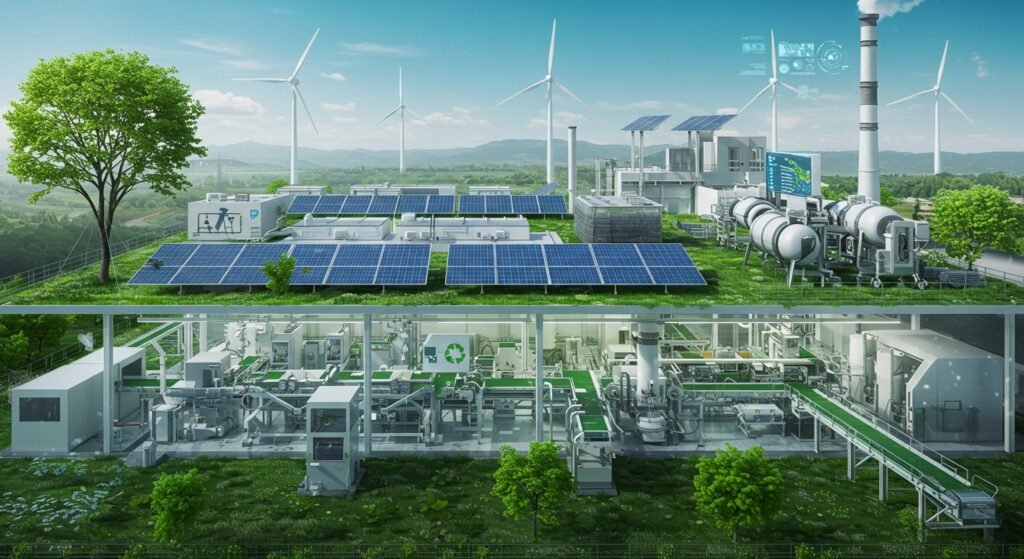In an era defined by increasing environmental consciousness, the adoption of Green Manufacturing Techniques has become paramount for industries worldwide. This paradigm shift, often driven by both consumer demand and regulatory pressures, focuses on minimizing environmental impact throughout the entire product lifecycle, from design and raw material sourcing to production, distribution, use, and end-of-life management. Embracing these techniques not only contributes to a healthier planet but also offers significant economic advantages, including reduced operational costs and enhanced brand reputation. As global industries strive for more sustainable practices, understanding and implementing these innovative methods is crucial for long-term success and environmental stewardship.
Table of Contents
- Understanding Green Manufacturing
- Key Green Manufacturing Techniques
- Benefits of Adopting Green Manufacturing
- The Future of Industrial Engineering and Sustainability
Understanding Green Manufacturing
What is Green Manufacturing?
Green manufacturing, also known as sustainable manufacturing, is the creation of manufactured products through economically sound processes that minimize negative environmental impacts while conserving energy and natural resources. It also enhances employee, community, and product safety. This approach integrates environmental considerations into every stage of the manufacturing process, moving beyond simple compliance to proactive environmental management.
Why is it Important?
The importance of green manufacturing extends beyond mere ecological responsibility. It’s a strategic imperative that addresses resource scarcity, escalating energy costs, stringent environmental regulations, and growing consumer preference for eco-friendly products. Businesses that adopt these practices often find themselves with a competitive edge, improved public image, and a more resilient supply chain. Furthermore, it directly contributes to global efforts to combat climate change and resource depletion.
Key Green Manufacturing Techniques
Several innovative approaches fall under the umbrella of Green Manufacturing Techniques, each offering unique ways to reduce environmental footprints and improve efficiency.
Renewable Energy Integration
One of the most impactful techniques involves transitioning from fossil fuels to renewable energy sources like solar, wind, and geothermal power for manufacturing operations. This significantly reduces greenhouse gas emissions and reliance on finite resources. Companies are investing in on-site renewable energy generation or purchasing renewable energy credits to power their facilities, leading to substantial carbon footprint reductions.
Waste Reduction and Recycling
Minimizing waste generation and maximizing recycling efforts are core to green manufacturing. This includes optimizing production processes to reduce scrap material, implementing robust recycling programs for industrial waste, and exploring upcycling opportunities. Many manufacturers are adopting a “closed-loop” system where waste from one process becomes a resource for another. For more insights into industrial waste management, you can visit the Environmental Protection Agency’s industrial waste section.
Lean Manufacturing Principles
While not exclusively environmental, lean manufacturing principles inherently support green goals by eliminating waste in all its forms – including material, energy, and time. By streamlining processes, reducing defects, and improving efficiency, lean practices lead to lower resource consumption and less pollution. This aligns perfectly with the objectives of sustainable industrial engineering. To learn more about efficiency, see our article on Optimizing Production Flow.
Sustainable Material Sourcing
Choosing materials that are renewable, recycled, recyclable, non-toxic, or produced through sustainable methods is critical. This includes using bio-based plastics, recycled metals, certified wood, and materials from ethical supply chains that minimize environmental degradation and social injustice.
Eco-Friendly Product Design
Designing products with their end-of-life in mind, known as “Design for Environment” (DfE), is a proactive green manufacturing technique. This involves creating products that are easy to disassemble, repair, reuse, and recycle, minimizing waste at the end of their useful life. It also focuses on reducing the number of components and using less material overall.
Benefits of Adopting Green Manufacturing
The advantages of implementing green manufacturing extend beyond environmental stewardship, offering tangible benefits to businesses:
| Benefit Category | Specific Advantages |
|---|---|
| Economic Savings | Reduced energy costs, lower waste disposal fees, decreased raw material expenses through recycling, potential tax incentives. |
| Brand & Reputation | Enhanced public image, increased customer loyalty, stronger investor relations, improved market position. |
| Compliance & Risk | Easier adherence to environmental regulations, reduced risk of penalties, proactive management of environmental liabilities. |
| Operational Efficiency | Optimized processes, less material waste, improved productivity, healthier work environment. |
The Future of Industrial Engineering and Sustainability
The trajectory of industrial engineering is inextricably linked with sustainability. As technology advances, new opportunities for green innovation emerge, from additive manufacturing (3D printing) that reduces material waste, to advanced robotics and AI that optimize energy consumption. The global push towards a circular economy—where resources are kept in use for as long as possible, extracting the maximum value from them whilst in use, then recovering and regenerating products and materials at the end of each service life—will continue to drive the evolution of green manufacturing. These trends indicate a future where economic growth and environmental responsibility are not mutually exclusive but deeply interconnected.
Adopting Green Manufacturing Techniques is no longer an option but a necessity for businesses aiming for long-term viability and positive global impact. By integrating sustainable practices into their core operations, companies can achieve remarkable efficiencies, reduce their ecological footprint, and build a resilient, future-proof enterprise. The transition requires commitment and innovation, but the rewards—for both planet and profit—are undeniable.


